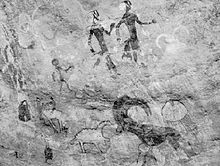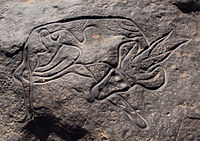Which Period of Rock Art in Africa Was the First to Develop
Significant Saharan rock art locations

Manda Guéli Cave in the Ennedi Mountains, northeastern Republic of chad
Saharan rock art is a significant area of archaeological written report focusing on artwork carved or painted on the natural rocks of the central Sahara desert. The stone fine art dates from numerous periods starting c.12,000 years ago, and is pregnant because it shows the civilisation of ancient African societies.
The paintings and carvings of the Sahara are endangered, and vulnerable rock art on uncovered rock has already disappeared. Organizations, such as the Trust for African Rock Fine art,[ane] are researching and recording every bit much information nearly Saharan rock art as possible, while raising awareness of threats to the art itself.
Archaeological sites [edit]
Important regions and sites include:
- Cavern of Swimmers and Cavern of Beasts caves surface area, Gilf Kebir surface area, Egypt
- Tibesti, Chad: Also known as Tibesti Massif or Tibesti Mountains located in central Sahara, extending from Niger and Libya. The mountains are volcanic and are approximately 300 miles (480 km) long and 175 miles (282 km) wide.[2] The rock fine art that exists in these mountains was created before dramatic climatic change in the Saharan Desert acquired the inhabitants to move towards the Nile Valley. Large brute engravings and other stone art dates to between 12,000 and iv,000 years ago.[3]
- Ennedi, Chad: Next to the Tibesti Mountain chain is another mountain chain named Ennedi. Much of the rock art in this expanse is from the Horse Period, and was made in the last ii,000 years. Pastoral Flow art was also shown here.[3]
- Messak Settafet, Libya: Abundant rock fine art is found in this location, near a mountain chain in Libya. Fine art is made from engraving techniques such as grinding, pecking, and scratching. Outlines of animals are constitute in blackened sandstone.[4]

- Tadrart Acacus, Libya: Near the sand dune of Murzuk, adjoining Tassili n'Ajjer, exists 12,000 yr sometime prehistoric rock art. It appears to reflect much of the same civilization equally the Tassili north'Ajjer rock art.[5]

To a higher place,Rock carving depicting a lying antelope or gazelle, located at Tin Taghirt on the Tassili n'Ajjer. Below, same rock carving depicted on the reverse of a 1992 1000 Algerian dinar banknote.
- Tassili n'Ajjer, Algeria: The cave paintings found at Tassili n'Ajjer, due north of Tamanrasset, Algeria, and at other locations draw bright scenes of everyday life in fundamental Northward Africa between about 10,000 BP and 6,000 BP, in the Later on Stone Age. There are over fifteen,000 individual pieces of artwork in Tassili n'Ajjer. The fine art includes paintings and engravings into the rock that depicts the civilisation of Africans up to 12,000 years ago. They were executed by a hunting people in the Capsian catamenia between v,000 and 3,900 BP who lived in a savanna region teeming with behemothic buffalo, elephant, rhinoceros, and hippopotamus, animals that no longer exist in the now-desert expanse. The site was founded by French anthropologist Henri Lhote 50 years agone, withal researchers are still discovering new artwork.[6]
- S Oran, Algeria
- Djelfa, Algeria
- Ahaggar, Algeria
- Draa River, Morocco
- Stone fine art of Figuig, Kingdom of morocco
- Aïr Mountains, Niger
- Sabu-Jaddi rock art site in Northern Sudan
Research techniques [edit]
Archaeologists, anthropologists, and other researchers have been studying rock art to gain information about African cultures from the by. Many photographs are taken of the art so it can be studied further. Dating the fine art of the Sahara is made possible through radiometric dating of organic material, including radiocarbon dating. Organic artifacts found at the sites can exist dated, equally tin some residues on the rock art itself.[seven]
Rock art time periods [edit]

Rock art from the Bubalus fourth dimension period in Tin can Taghirt
- Big Wild Fauna Period (12,000 BP - 6000 BP):[eight] Saharan hunter-gatherer societies first made rock art. These images included animals that then lived in the area, including hippos, rhinos, elephants, giraffes, bubalus, aurochs, and large antelopes. Many of those animals no longer exist in the Sahara due to changes in climate that take acquired the desiccation of the desert over the by several thousand years. Humans are shown hunting with spears and axes. The artwork portrays non but hunting, only the human relationship between humans and animals. Almost of the artwork tin be found in Tassili n'Ajjer, Algeria.[viii]
- Kel Essuf Period (9800 BP):[nine] The Kel Essuf stone art tradition of engraving may take developed into the Round Caput rock art tradition of painting.[10]
- Round Head Catamenia (9500 BP - 7000 BP):[8] Hunter-gatherers on the Tassili Plateau painted distinctive human being figures with round, characterless heads.
- Pastoral Catamenia (7200 BP - 3000 BP):[8] During this menstruum, humans were depicted with domesticated cattle. Pictures show cultures herding animals and hunting equally well, portrayed through men holding bows. Women and children are in camps where they lived. This style is shown effectually the Sahara with paintings and engravings. Herders eventually migrated to the west, eastward, and south equally Saharan climates aridified.[8]
- Equus caballus Period (3200 BP - thou BP):[8] Humans are shown with horses during this menses. Paintings and few engravings accept men on horses with weapons, also as horse-fatigued chariots. The people are also dressed in article of clothing instead of no wearable at all.[8]
- Camel Period (3000 BP - 2000 BP):[8] This is the final flow of rock art in the Sahara, with images of camels appearing. Cattle and goats are ofttimes included in Camel Catamenia art as well. Advanced weaponry is depicted, including pictures of men with spears, swords, and shields.[8]
See also [edit]
- Rock fine art
- Prehistoric art
- List of Stone Age art
- Association des Amis de l'Art Rupestre Saharien
- African boiling period
References [edit]
- ^ "Trust for African Rock Art (TARA)".
- ^ "Tibesti | mountains, Africa". Encyclopædia Britannica . Retrieved 2016-12-12 .
- ^ a b "Rock Art of Republic of chad - Trust for African Rock Art". Trust for African Rock Art . Retrieved 2016-12-fourteen .
- ^ Temehu.com. "The Rock Engravings of Messak Settafet & Mellet". world wide web.temehu.com . Retrieved 2016-12-14 .
- ^ Temehu.com. "Tadrart Acacus (Akakus or Akakous)". www.temehu.com . Retrieved 2016-12-14 .
- ^ Coulson, David; Campbell, Alec. "Rock Art of the Tassili north'Ajjer, Algeria" (PDF). AfricanRockArt.org.
- ^ "Prehistoric African Paintings and Engravings". Trust for African Stone Art . Retrieved 2016-xi-02 .
- ^ a b c d e f g h i Coulson, David; Campbell, Alec. "Rock Art of the Tassili due north'Ajjer, Algeria" (PDF). AfricanRockArt.org.
- ^ Soukopova, Jitka (2017). "Fundamental Saharan stone art: Because the kettles and cupules". Journal of Arid Environments. 143: 10. Bibcode:2017JArEn.143...10S. doi:10.1016/j.jaridenv.2016.12.011.
- ^ Soukopova, Jitka (Jan 16, 2013). Round Heads: The Primeval Stone Paintings in the Sahara. Cambridge Scholars Publishing. p. 38. ISBN9781443845793.
Source: https://en.wikipedia.org/wiki/Saharan_rock_art
0 Response to "Which Period of Rock Art in Africa Was the First to Develop"
Postar um comentário